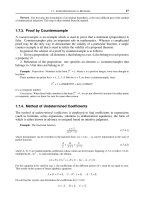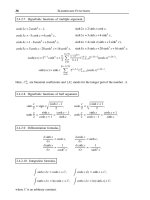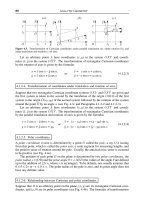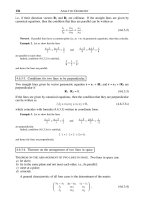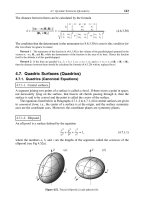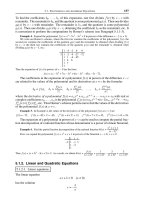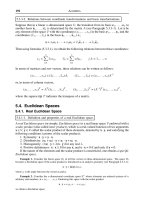Handbook of mathematics for engineers and scienteists part 108 pps
Bạn đang xem bản rút gọn của tài liệu. Xem và tải ngay bản đầy đủ của tài liệu tại đây (425.18 KB, 7 trang )
15.8. CLASSICAL METHOD OF STUDYING SYMMETRIES OF DIFFERENTIAL EQUATIONS 717
Remark. In the special case of transformations in the plane, the functions ϕ
1
and ϕ
2
in (15.8.1.1) are
independent of w,andψ = w (i.e., ¯w = w).
The expansion of (15.8.1.1) into truncated Taylor series in ε about ε = 0 to linear terms
gives
¯x x + εξ(x, y, w), ¯y y + εη(x, y, w), ¯w w + εζ(x, y, w), (15.8.1.2)
where
ξ(x, y, w)=
∂ϕ
1
∂ε
ε=0
, η(x, y, w)=
∂ϕ
2
∂ε
ε=0
, ζ(x, y, w)=
∂ψ
∂ε
ε=0
.
The linear first-order differential operator
X=ξ(x, y, w)
∂
∂x
+ η(x, y, w)
∂
∂y
+ ζ(x, y, w)
∂
∂w
,(15.8.1.3)
which corresponds to the infi nitesimal transformation (15.8.1.2), is called an infinitesimal
operator.*
T
HEOREM (LIE).
Suppose the coordinates
ξ(x, y, w)
,
η(x, y, w)
,
ζ(x, y, z)
of the in-
finitesimal operator (15.8.1.3) are known. Then the transformation (15.8.1.1), having the
group property, can be completely recovered by solving the Lie equations
dϕ
1
dε
= ξ(ϕ
1
, ϕ
2
, ψ),
dϕ
2
dε
= η(ϕ
1
, ϕ
2
, ψ),
dψ
dε
= ζ(ϕ
1
, ϕ
2
, ψ)
with the initial conditions
ϕ
1
|
ε=0
= x, ϕ
2
|
ε=0
= y, ψ|
ε=0
= w.
15.8.1-2. Invariant of an infinitesimal operator. Transformations in the plane.
An invariant of the operator (15.8.1.3) is a function I(x, y, w) that satisfies the condition
I(¯x, ¯y, ¯w)=I(x, y, w).
Let us expand this equation in Taylor series in the small parameter ε, divide the resulting
relation by ε, and the proceed to the limit as ε → 0 to obtain a linear partial differential
equation for I:
XI = ξ(x, y, w)
∂I
∂x
+ η(x, y, w)
∂I
∂y
+ ζ(x, y, w)
∂I
∂w
= 0.(15.8.1.4)
Let the associated characteristic system of ordinary differential equations (see Paragraph
13.1.1-3)
dx
ξ(x, y, w)
=
dy
η(x, y, w)
=
dw
ζ(x, y, w)
(15.8.1.5)
* In the literature, it is also known as an infinitesimal generator or a group generator. In this book, we call
an operator (15.8.1.3) an infinitesimal operator, a group generator, or, for short, an operator.
718 NONLINEAR PARTIAL DIFFERENTIAL EQUATIONS
TABLE 15.7
One-parameter transformations in the plane
Name Transformation Transformation Invariant
Translation in the x-axis
¯x = x + ε, ¯y = y
X=
∂
∂x
I
1
= y
Translation along the straight line
ax + by = 0
¯x = x + bε, ¯y = y – aε
X=b
∂
∂x
– a
∂
∂y
I
1
= ax + by
Rotation
¯x = x cos ε + y sin ε,
¯y = y cos ε – x sin ε
X=y
∂
∂x
– x
∂
∂y
I
1
= x
2
+ y
2
Galileo transformation
¯x = x + εy, ¯y = y
X=y
∂
∂x
I
1
= y
Lorentz transformation
¯x = x cosh ε + y sinh ε,
¯y = y cosh ε + x sinh ε
X=y
∂
∂x
+ x
∂
∂y
I
1
= y
2
– x
2
Uniform extension
¯x = xe
ε
, ¯y = ye
ε
X=x
∂
∂x
+ y
∂
∂y
I
1
= y/x
Nonuniform extension
¯x = xe
aε
, ¯y = ye
bε
X=ax
∂
∂x
+ by
∂
∂y
I
1
= |y|
a
|x|
–b
have the functionally independent integrals
I
1
(x, y, w)=C
1
, I
2
(x, y, w)=C
2
,(15.8.1.6)
where C
1
and C
2
are arbitrary constants. Then the general solution of equation (15.8.1.4)
has the from
I = Ψ(I
1
, I
2
), (15.8.1.7)
where Ψ(I
1
, I
2
) is an arbitrary function of two arguments, I
1
=I
1
(x, y, w)andI
2
=I
2
(x, y, w).
This means that the operator (15.8.1.3) has two functionally independent invariants,
I
1
and I
2
, and any function Φ(x, y, w) invariant under the operator (15.8.1.3) can be repre-
sented as a function of the two invariants.
Table 15.7 lists the most common transformations in the plane and the corresponding
operator (15.8.1.3) and invariants; only one invariant is specified, with the other being the
same: I
2
= w.
15.8.1-3. Formulas for derivatives. Coordinates of the first and second prolongations.
In the new variables (15.8.1.1), the first derivatives become
∂ ¯w
∂ ¯x
∂w
∂x
+ εζ
1
,
∂ ¯w
∂¯y
∂w
∂y
+ εζ
2
.(15.8.1.8)
Here, ζ
1
and ζ
2
are the coordinates of the first prolongation, which are found as
ζ
1
= D
x
(ζ)–w
x
D
x
(ξ)–w
y
D
x
(η)=ζ
x
+(ζ
w
– ξ
x
)w
x
– η
x
w
y
– ξ
w
w
2
x
– η
w
w
x
w
y
,
ζ
2
= D
y
(ζ)–w
x
D
y
(ξ)–w
y
D
y
(η)=ζ
y
– ξ
y
w
x
+(ζ
w
– η
y
)w
y
– ξ
w
w
x
w
y
– η
w
w
2
y
,
(15.8.1.9)
where D
x
and D
y
are the total differential operators with respect to x and y:
D
x
=
∂
∂x
+ w
x
∂
∂w
+ w
xx
∂
∂w
x
+ w
xy
∂
∂w
y
+ ···,
D
y
=
∂
∂y
+ w
y
∂
∂w
+ w
xy
∂
∂w
y
+ w
yy
∂
∂w
y
+ ···.
(15.8.1.10)
15.8. CLASSICAL METHOD OF STUDYING SYMMETRIES OF DIFFERENTIAL EQUATIONS 719
Let us verify that the first formula in (15.8.1.8) holds. Obviously,
¯w
x
= ¯w
¯x
¯x
x
+ ¯w
¯y
¯y
x
, ¯w
y
= ¯w
¯x
¯x
y
+ ¯w
¯y
¯y
y
. (15.8.1.11)
Differentiating (15.8.1.2) with respect to x and y and retaining terms to the first order of ε,wehave
¯x
x
= 1 + εD
x
ξ, ¯x
y
= εD
y
ξ,
¯y
x
= εD
x
η, ¯y
y
= 1 + εD
y
η,
¯w
x
= w
x
+ εD
x
ζ, ¯w
y
= w
y
+ εD
y
ζ.
(15.8.1.12)
In order to calculate ¯w
¯x
, let us eliminate ¯w
¯y
from (15.8.1.11) and then substitute the derivatives ¯x
x
, ¯x
y
, ¯y
x
,
¯y
y
, ¯w
x
, ¯w
y
for their respective expression from (15.8.1.12) to obtain
¯w
¯x
=
w
x
+ ε(D
x
ζ + w
x
D
y
η – w
y
D
x
η)+ε
2
(D
x
ζD
y
η – D
x
ηD
y
ζ)
1 + ε(D
x
ξ + D
y
η)+ε
2
(D
x
ξD
y
η – D
x
ηD
y
ξ)
.
Expanding into a series in ε,wehave
¯w
¯x
w
x
+ εζ
1
, ζ
1
= D
x
ζ – w
x
D
x
ξ – w
y
D
x
η,
which was to be proved. The coordinate ζ
2
is calculated likewise.
The second derivatives in the new variables (15.8.1.1) are calculated as
∂
2
¯w
∂ ¯x
2
∂
2
w
∂x
2
+ εζ
11
,
∂
2
¯w
∂ ¯x∂¯y
∂
2
w
∂x∂y
+ εζ
12
,
∂
2
¯w
∂¯y
2
∂
2
w
∂y
2
+ εζ
22
.(15.8.1.13)
Here, the ζ
ij
are the coordinates of the second prolongation and are found as
ζ
11
= D
x
(ζ
1
)–w
xx
D
x
(ξ)–w
xy
D
x
(η),
ζ
12
= D
y
(ζ
1
)–w
xx
D
y
(ξ)–w
xy
D
y
(η),
ζ
22
= D
y
(ζ
2
)–w
xy
D
y
(ξ)–w
yy
D
y
(η),
or, in detailed form,
ζ
11
= ζ
xx
+(2ζ
wx
– ξ
xx
)w
x
– η
xx
w
y
+(ζ
ww
– 2ξ
wx
)w
2
x
– 2η
wx
w
x
w
y
–
– ξ
ww
w
3
x
– η
ww
w
2
x
w
y
+(ζ
w
– 2ξ
x
– 3ξ
w
w
x
– η
w
w
y
)w
xx
– 2(η
x
+ η
w
w
x
)w
xy
,
ζ
12
= ζ
xy
+(ζ
wy
– ξ
xy
)w
x
+(ζ
wx
– η
xy
)w
y
– ξ
wy
w
2
x
–
–(ζ
ww
– ξ
wx
– η
wy
)w
x
w
y
– η
wx
w
2
y
– ξ
ww
w
2
x
w
y
– η
ww
w
x
w
2
y
–
–(ξ
y
+ ξ
w
w
y
)w
xx
+(ζ
w
– ξ
x
– η
y
– 2ξ
w
w
x
– 2η
w
w
y
)w
xy
–(η
x
+ η
w
w
x
)w
yy
,
ζ
22
= ζ
yy
– ξ
yy
w
x
+(2ζ
wy
– η
yy
)w
y
– 2ξ
wy
w
x
w
y
+(ζ
ww
– 2η
wy
)w
2
y
–
– ξ
ww
w
x
w
2
y
– η
ww
w
3
y
– 2(ξ
y
+ ξ
w
w
y
)w
xy
+(ζ
w
– 2η
y
– ξ
w
w
x
– 3η
w
w
y
)w
yy
.
(15.8.1.14)
The above formulas for the coordinates of the first and second prolongation, (15.8.1.9)
and (15.8.1.14), will be required later for the analysis of differential equations.
15.8.2. Symmetries of Nonlinear Second-Order Equations.
Invariance Condition
15.8.2-1. Invariance condition. Splitting in derivatives.
We will consider second-order partial differential equations in two independent variables
F
x, y, w,
∂w
∂x
,
∂w
∂y
,
∂
2
w
∂x
2
,
∂
2
w
∂x∂y
,
∂
2
w
∂y
2
= 0.(15.8.2.1)
720 NONLINEAR PARTIAL DIFFERENTIAL EQUATIONS
The procedure for finding symmetries* of equation (15.8.2.1) consists of several stages.
At the first stage, one requires that equation (15.8.2.1) must be invariant (preserve its form)
under transformations (15.8.1.1), so that
F
¯x, ¯y, ¯w,
∂ ¯w
∂ ¯x
,
∂ ¯w
∂¯y
,
∂
2
¯w
∂ ¯x
2
,
∂
2
¯w
∂ ¯x∂¯y
,
∂
2
¯w
∂¯y
2
= 0.(15.8.2.2)
Let us expand this equation into a series in ε about ε = 0, taking into account that the leading
term vanishes, according to (15.8.2.1). Using formulas (15.8.1.2), (15.8.1.8), (15.8.1.13)
and retaining the terms to the first-order of ε, we obtain
X
2
F
x, y, w,
∂w
∂x
,
∂w
∂y
,
∂
2
w
∂x
2
,
∂
2
w
∂x∂y
,
∂
2
w
∂y
2
F =0
= 0,(15.8.2.3)
where
X
2
F = ξ
∂F
∂x
+η
∂F
∂y
+ζ
∂F
∂w
+ζ
1
∂F
∂w
x
+ζ
2
∂F
∂w
y
+ζ
11
∂F
∂w
xx
+ζ
12
∂F
∂w
xy
+ζ
22
∂F
∂w
yy
.(15.8.2.4)
The coordinates of the first, ζ
i
, and the second, ζ
ij
, prolongation are defined by formulas
(15.8.1.9) and (15.8.1.14). Relation (15.8.2.3) is called the invariance condition,andthe
operator X
2
is called the second prolongation of the operator (15.8.1.3).
At the second stage, either the derivative
∂
2
w
∂y
2
or
∂
2
w
∂x
2
is eliminated from (15.8.2.3) using
equation (15.8.2.1). The resulting relation is then written as a polynomial in the “inde-
pendent variables,” the various combinations of the products of the derivatives (involving
various powers of w
x
, w
y
, w
xx
,andw
xy
):
A
k
1
k
2
k
3
k
4
(w
x
)
k
1
(w
y
)
k
2
(w
xx
)
k
3
(w
xy
)
k
4
= 0,(15.8.2.5)
where the functional coefficients A
k
1
k
2
k
3
k
4
are dependent on x, y, w, ξ, η, ζ and the deriva-
tives of ξ, η, ζ only and are independent of the derivatives of w. Equation (15.8.2.5) is
satisfied if all A
k
1
k
2
k
3
k
4
are zero. Thus, the invariance condition is split to an overdeter-
mined determining system, resulting from equating all functional coefficients of the various
products of the remaining derivatives to zero (recall that the unknowns ξ, η,andζ are
independent of w
x
, w
y
, w
xx
,andw
xy
).
At the third stage, one solves the determining system and finds admissible coordinates
ξ, η,andζ of the infinitesimal operator (15.8.1.3).
Remark 1. It should be noted that the functional coefficients A
k
1
k
2
k
3
k
4
and the determining system are
linear in the unknowns ξ, η,andζ.
Remark 2. Aninvariant I that is a solution of equation (15.8.1.4) is also a solution of the equation X
2
I = 0.
The procedure for finding symmetries of differential equations is illustrated below by
specificexamples.
15.8.2-2. Examples of finding symmetries of nonlinear equations.
Example 1. Consider the two-dimensional stationary heat equation with a nonlinear source
∂
2
w
∂x
2
+
∂
2
w
∂y
2
= f(w). (15.8.2.6)
The corresponding left-hand side of equation (15.8.2.1) is F = w
xx
+ w
yy
– f(w).
* A symmetry of an equation is a transformation that preserves its form.
15.8. CLASSICAL METHOD OF STUDYING SYMMETRIES OF DIFFERENTIAL EQUATIONS 721
Infinitesimal operators X admitted by the equations are sought in the form (15.8.1.4), where the coordinates
ξ = ξ(x, y, w), η = η(x, y, w), ζ = ζ(x, y, w) are yet unknown and are to be determined in the subsequent analysis.
In view of identity F = w
xx
+ w
yy
– f(w), the invariance condition (15.8.2.3)–(15.8.2.4) is written as
ζ
22
+ ζ
11
– ζf
(w)=0.
Substituting here the expressions of the coordinates of the second prolongation (15.8.1.14) and then replacing
w
yy
by f (w)–w
xx
, which follows from equation (15.8.2.6), we obtain
– 2ξ
w
w
x
w
xx
+ 2η
w
w
y
w
xx
– 2η
w
w
x
w
xy
– 2ξ
w
w
y
w
xy
– 2(ξ
x
– η
y
)w
xx
– 2(ξ
y
+ η
x
)w
xy
–
– ξ
ww
w
3
x
– η
ww
w
2
x
w
y
– ξ
ww
w
x
w
2
y
– η
ww
w
3
y
+(ζ
ww
– 2ξ
xw
)w
2
x
– 2(ξ
yw
+ η
xw
)w
x
w
y
+
+(ζ
ww
– 2η
yw
)w
2
y
+(2ζ
xw
– ξ
xx
– ξ
yy
– fξ
w
)w
x
+(2ζ
yw
– η
xx
– η
yy
– 3fη
w
)w
y
+
+ ζ
xx
+ ζ
yy
+ f(ζ
w
– 2η
y
)–ζf
= 0,
where f = f(w)andf
= df / d w . Equating the coefficients of all combinations of the derivatives to zero, we
have the system
w
x
w
xx
: ξ
w
= 0,
w
y
w
xx
: η
w
= 0,
w
xx
: ξ
x
– η
y
= 0,
w
xy
: ξ
y
+ η
x
= 0,
w
2
x
: ζ
ww
– 2ξ
wx
= 0,
w
x
w
y
: η
wx
+ ξ
wy
= 0,
w
x
: 2ζ
wx
– ξ
xx
– ξ
yy
– ξ
w
f(w)=0,
w
2
y
: ζ
ww
– 2η
wy
= 0,
w
y
: 2ζ
wy
– η
xx
– η
yy
– 3η
w
f(w)=0,
1: ζ
xx
+ ζ
yy
– f
(w)ζ + f(w)(ζ
w
– 2η
y
)=0.
(15.8.2.7)
Here, the left column indicates a combination of the derivatives and the right column gives the associated
coefficient. The coefficients of w
y
w
xy
, w
x
w
xy
, w
3
x
, w
2
x
w
y
, w
x
w
2
y
, w
3
y
either are among those already listed
or are their differential consequences, and therefore they are omitted. It follows from the first, second, and fifth
equations and their consequences that
ξ = ξ(x, y), η = η(x, y), ζ = a(x, y)w + b(x, y). (15.8.2.8)
The third and fourth equations of system (15.8.2.7) give
ξ
xx
+ ξ
yy
= 0, η
xx
+ η
yy
= 0.(15.8.2.9)
Substituting (15.8.2.8) into the seventh and ninth equations of (15.8.2.7) and using (15.8.2.9), we find that
a
x
= a
y
= 0, whence
a(x, y)=a = const. (15.8.2.10)
In view of (15.8.2.8) and (15.8.2.10), system (15.8.2.7) becomes
ξ
x
– η
y
= 0,
ξ
y
+ η
x
= 0,
b
xx
+ b
yy
– awf
(w)–bf
(w)+f (w)(a – 2η
y
)=0.
(15.8.2.11)
For arbitrary f, it follows that a = b = η
y
= 0,andthenξ = C
1
y +C
2
, η =–C
1
x + C
3
,andζ = 0. By setting one
of the constants to unity and the others to zero, we establish that the original equation admits three different
operators:
X
1
= ∂
x
(C
2
= 1, C
1
= C
3
= 0);
X
2
= ∂
y
(C
3
= 1, C
1
= C
2
= 0);
X
3
= y∂
x
– x∂
y
(C
1
= 1, C
2
= C
3
= 0).
(15.8.2.12)
The first two operators define a translation along the x-andy-axis. The third operator represents a rotational
symmetry.
Let us dwell on the third equation of system (15.8.2.11). If the relation
(aw + b)f
(w)–f(w)(a – 2η
y
)=0 (15.8.2.13)
722 NONLINEAR PARTIAL DIFFERENTIAL EQUATIONS
holds, there may exist other solutions of system (15.8.2.11) that will result in operators other than (15.8.2.12).
Let us study two cases: a ≠ 0 and a = 0.
Case 1.Ifa ≠ 0, the solution of equation (15.8.2.13) gives
f(w)=C(aw + b)
1
2γ
a
,
where γ = η
y
= const and b = const. Therefore, for f(w)=w
k
, equation (15.8.2.6) admits another operator,
X
4
= x∂
x
+ y∂
y
+
2
1 – k
w∂
w
,
that defines a nonuniform extension.
Case 2.Ifa = 0,wehave
f(w)=Ce
λw
,
where λ = const. Then b =–2η
y
/λ, and the functions ξ and η satisfy the first two equations (15.8.2.11), which
coincide with the Cauchy–Riemann conditions for analytic functions. The real and the imaginary part of any
analytic function, Φ(z)=ξ(x, y)+iη(x, y), of the complex variable z = x + iy satisfies the Cauchy–Riemann
conditions. In particular, if b = const and f (w)=e
w
, the equation admits another operator,
X
4
= x∂
x
+ y∂
y
– 2∂
w
,
which corresponds to extension in x and y with simultaneous translation in w.
Example 2. Consider the nonlinear nonstationary heat equation
∂w
∂t
=
∂
∂x
f(w)
∂w
∂x
. (15.8.2.14)
In the invariance condition (15.8.2.3)–(15.8.2.4), one should set
y = t, F = w
t
– f(w)w
xx
– f
(w)w
2
x
, ζ
12
= ζ
22
= 0.
The coordinates of the first and second prolongations, ζ
1
, ζ
2
,andζ
11
, are expressed by (15.8.1.9) and (15.8.1.14)
with y = t. In the resulting equation, one should replace w
t
with the right-hand side of equation (15.8.2.14)
and equate the coefficients of the various combinations of the remaining derivatives to zero, thus arriving at the
system of equations
w
x
w
xx
: 2f(w)[η
wx
f(w)+ξ
w
]+f
(w)η
x
= 0,
w
xx
: ζf
(w)–f
2
(w)η
xx
– f(w)(2ξ
x
– η
t
)=0,
w
x
w
xt
: f(w)η
w
= 0,
w
xt
: f(w)η
x
= 0,
w
4
x
: f
(w)η
w
+ f(w)η
ww
= 0,
w
3
x
: 2[f
(w)]
2
η
x
+ f(w)ξ
ww
+ f
(w)ξ
w
+ 2f(w)f
(w)η
wx
= 0,
w
2
x
: f(w)ζ
ww
+ f
(w)ζ – 2f(w)ξ
wx
– f
(w)(2ξ
x
– η
t
)+f
(w)ζ
w
– f(w)f
(w)η
ww
= 0,
w
x
: 2f(w)ζ
wx
+ 2f
(w)ζ
x
– f(w)ξ
xx
+ ξ
t
= 0,
1: ζ
t
– f(w)ζ
xx
= 0.
Here, the left column indicates a combination of the derivatives, and the right column gives the associated
equation (to a constant factor); identities and differential consequences are omitted. Since f(w)
0, it follows
from the third and fourth equations of the system that η = η(t). Then from the first and second equations, we
have
ξ = ξ(x, t), ζ =
f(w)(2ξ
x
– η
t
)
f
(w)
.
With these relations, the remaining equations of the system become
[ff
f
– f(f
)
2
+(f
)
2
f
](2ξ
x
– η
t
)=0,
f[4ff
– 7(f
)
2
]ξ
xx
–(f
)
2
ξ
t
= 0,
2fξ
xxx
– 2ξ
xt
+ η
tt
= 0;
15.8. CLASSICAL METHOD OF STUDYING SYMMETRIES OF DIFFERENTIAL EQUATIONS 723
the equations have been canceled by nonzero factors. In the general case, for arbitrary function f, from the
first equation it follows that 2ξ
x
– η
t
= 0 and from the second it follows that ξ
t
= 0. The third equation gives
ξ = C
1
+ C
2
x,andthenη = 2C
2
t + C
3
. Therefore, for arbitrary f, equation (15.8.2.14) admits three operators
X
1
= ∂
x
(C
1
= 1, C
2
= C
3
= 0);
X
2
= ∂
t
(C
3
= 1, C
1
= C
2
= 0);
X
3
= 2t∂
t
+ x∂
x
(C
2
= 1, C
1
= C
3
= 0).
Similarly, it can be shown that the following special forms of f result in additional operators:
1. f = e
w
:X
4
= x∂
x
+ 2∂
w
;
2. f = w
k
, k ≠ 0,–4/3:X
4
= kx∂
x
+ 2w∂
w
;
3. f = w
–4/3
:X
4
= 2x∂
x
– 3w∂
w
,X
5
= x
2
∂
x
– 3xw∂
w
.
Example 3. Consider now the nonlinear wave equation
∂
2
w
∂t
2
=
∂
∂x
f(w)
∂w
∂x
. (15.8.2.15)
In the invariance condition (15.8.2.3)–(15.8.2.4), one should set
y = t, F = w
tt
– f(w)w
xx
– f
(w)w
2
x
, ζ
2
= ζ
12
= 0,
and use the coordinates of the first and second prolongations, ζ
1
, ζ
11
,andζ
22
, expressed by (15.8.1.9) and
(15.8.1.14) with y = t. In the resulting equation, one should replace w
tt
with the right-hand side of equation
(15.8.2.15) and equate the coefficients of the various combinations of the remaining derivatives to zero, thus
arriving at the system of equations
w
x
w
xx
: f(w)ξ
w
= 0,
w
t
w
xx
: f(w)η
w
= 0,
w
xx
: f
(w)ζ + 2f(w)(η
t
– ξ
x
)=0,
w
xt
: f(w)η
x
– ξ
t
= 0,
w
3
x
: f
(w)ξ
w
+ f(w)ξ
ww
= 0,
w
2
x
w
t
: f(w)η
ww
– f
(w)η
w
= 0,
w
2
x
: f(w)ζ
ww
+ f
(w)ζ
w
+ f
(w)ζ – 2f(w)ξ
wx
– 2f
(w)(ξ
x
– η
t
)=0,
w
x
w
t
: 2f
(w)η
x
+ 2f(w)η
wx
– 2ξ
wt
= 0,
w
x
: 2f
(w)ζ
x
– f(w)ξ
xx
+ 2f(w)ζ
wx
+ ξ
tt
= 0,
w
2
t
: ζ
ww
– 2η
wt
= 0,
w
t
: f(w)η
xx
+ 2ζ
wt
– η
tt
= 0,
1: ζ
tt
– f(w)ζ
xx
= 0.
Identities and differential consequences have been omitted. Since f(w) ≠ const, it follows from the first two
equations that ξ = ξ(x, t)andη = η(x, t). The tenth equation of the system becomes ζ
ww
= 0, thus giving
ζ = a(x,t)w + b(x, t). As a result, the system becomes
wf
(w)a(x, y)+f
(w)b(x, y)+2f(w)(η
t
– ξ
x
)=0,
f
(w)a(x, y)+wf
(w)a(x, y)+f
(w)b(x, y)–2f
(w)(ξ
x
– η
t
)=0,
2f
(w)(a
x
w + b
x
)–f(w)ξ
xx
+ 2f(w)a
x
= 0,
2a
t
– η
tt
= 0,
a
tt
w + b
tt
– f(w)(a
xx
w + b
xx
)=0.
For arbitrary function f(w), we have a = b = 0, ξ
xx
= 0, η
tt
= 0,andξ
x
– η
t
= 0. Integrating yields three
operators:
X
1
= ∂
x
,X
2
= ∂
t
,X
3
= x∂
x
+ t∂
t
.



